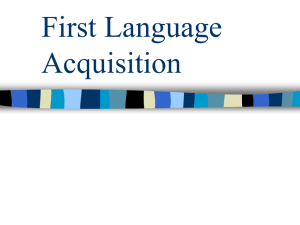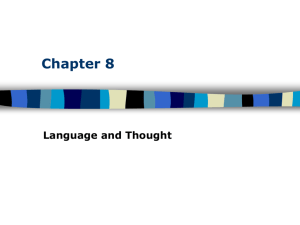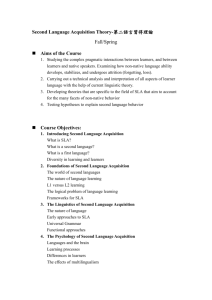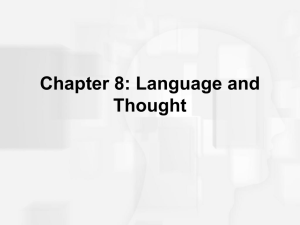Learning Theories
advertisement
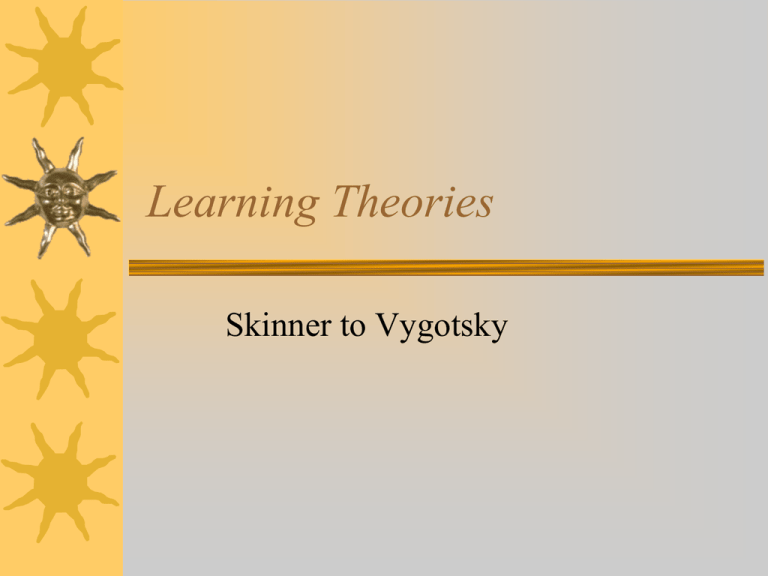
Learning Theories Skinner to Vygotsky Behaviorism (Skinner, Thorndike) Based on the concept that all learning can be studied through observed behaviors. Stimulus-Response is key to learning. – Stimulus: Events encountered in learning. – Response: What happens in reaction to stimulus. – Reinforcement: Appropriate S-R interaction is rewarded, inappropriate S-R interaction is punished. Behaviorism (Skinner, Thorndike) Readiness: A series of S-R can be connected if geared towards a larger goal. Practice: S-R events should take small, repeated steps to allow for reinforcement. Gestalt Theory (Wertheimer) The “Ah-ha” theory. Higher order thinking skills. – “Groupings” based on characteristics are key. – Learning takes place through the discovery of the relationship between elements. – Gaps in groupings leads to exploring possibilities. Progressivism (Dewey) Education is a lifetime event. It should not be viewed as a preparation for life. – Schooling should be related to the life of the student. – Students should explore problem resolution situations (projects). Subject matter should be presented to help resolve problem. – The relationships in the classroom should be of working together to complete projects. Genetic Epistemology (Piaget) Cognitive structure (mind and intelligence) pass through biological developmental stages. – Sensorimotor (0-2 years): Motor actions – Preoperation (3-7): Intuitive, reactional – Concrete operational (8-11): logical with concrete referents. – Formal operations (12-15): Movement to abstractions Genetic Epistemology (Piaget) Cognitive structures change through adaptation: – Assimilation: interpretations of events through present cognitive structures – Accommodation: change to cognitive structure to explain environment. Constructivism (Bruner) Learning is an active process through which the learner connects new information to previously learned information. – Discovery based – Connect to students’ interests – Spiral based structure to teaching (provides students the opportunity to add to schema) Social Development (Vygotsky) Learning take place through social interaction. Learning progresses through stages that expose students to knowledge just beyond present state. (ZPD) – Requires assistance from someone more advanced in this area. Students use socially constructed tools (language, gestures, etc.) to negotiate meaning. LANGUAGE www.ucalgary.ca/~mueller/P365/language.ppt Language is fundamental to thinking and cognition, even isomorphic with cognitive processes in North American psychology Explanations of language learning Psycho-linguists, e.g., Chomsky – “Language Acquisition Device” innate – “preparedness”? Psychologists, e.g., Skinner – Reinforcement • Sudden? Full strength? Creative? – Pavlov’s “second signal system” Cognitive science Linguistic relativism? Sapir - Whorf hypothesis: Language habits predispose interpretation; “cold” means differently in Calgary compared to Cancun? Post-modernism …. Can anyone understand anyone else? Linguistic universality? For example, color words actually do not proliferate without number, just about a dozen common ones across cultures “Eskimos” do not have hundreds of words for “snow” Gender differences? Men: language is for – Negotiation – Preserving independence – Avoiding failure Women: language is for – Establishing connections – Establishing support & confirmation – reaching consensus Linguistic “Determinism” -- not Linguistic “relativism” does not imply “determinism” -- can differences in thinking overcome any absent words (thoughts and language not one and same) Even relativism overstated, e.g., note the “cooperative principle” (Grice) -presumed to be seeking mutual understanding (but also Verbal Self Defense! http://www.worldvsdleague.com/) How is language acquired? Innate processes? Experience, learning? Something else? Several things? Theories of Second Language Acquisition (SLA) Adapted from Ellis, R. (1986) “Understanding Second Language Acquisition Acculturation Model (J. Schumann) SLA is one aspect of acculturation The degree of acculturation will control the degree of SLA – Social distance • Factors which interact between the native and target groups. – Psychological distance • Affective factors which impact on the individual learner. Social Distance Good Learning L1 & L2 groups are of equal status Both groups hope for learner to assimilate in target group Both groups believe that L2 group shares social sphere Small, non-cohesive L2 group L2’s culture is compatible with target group Both groups have positive attitudes for other group L2 group will be in target language for extended time period Bad Learning One group has higher status than other Target group attempt to limit assimilation L2 group maintains own social sphere Larger, cohesive L2 group Cultures come into conflict One or both groups have negative feelings for other group L2 use of target language is temporary Psychological Distance Language shock – fear, doubt, and confusion when using target language Culture shock – fear, stress, disorientation due to negotiating new culture Motivation Ego boundaries – How much risk they are willing to take Pidginization Hypothesis – Interlanguage development (the individual languages developed by those in the early stages of SLA) becomes fossilized when social & psychological distances are great. These distances limit input The use of language remains at the communicative stage – Communicative function: transmission of referential (basic) information – Integrative function: language that marks a person as member of group – Expressive function: language that displays “linguistic virtuosity” Accommodation Theory (H. Giles) Similar to Acculturation Theory in that both attempt to explain how group relations impact SLA – Acculturation: Actual distance between groups – Accommodation: Perceived distance between groups Social distances are in constant negotiation Motivation is primary factor in SLA – It is a reflex of how learners define themselves in ethnic terms Factors that impact identity – Identification with specific “ingroup” (native) – Inter-ethnic comparisons: One group is better than other – Perception of ethno-linguistic vitality – Perception of ingroup boundaries: hard boundaries (separation from other group), soft boundaries (blending of language and culture) – Identification and status with ingroup social categories: occupation, religion, etc. Ethnic speech markers are used to show relationships in particular settings – Upward Convergence: User is positively motivated towards outgroup. Attempts to limit speech markers – Downward divergence: User is negatively motivated towards outgroup, accentuates speech markers. Variable Competence Model (R. Ellis) The way a language is learned is a reflection of how it is used. – Product: continuum of discourse types ranging from entirely planned to entirely unplanned – Process: Distinction between linguistic knowledge (rules) and the ability to use this knowledge (appropriate use of language as well as correct use) Language develops as user applies the knowledge of language to contextual situations – Variable competence: user possesses a heterogeneous rule system – Variable application of procedures: user applies a variety or procedures to confirm language knowledge Language acquisition is the result of making sense of language events – There is a single knowledge store containing the variable rules for language use (automatic & analyzed) – The learner has a capacity for language use with both primary (unplanned & unanalyzed) and secondary (planned & analyzed) discourse processes – L2 performance is variable based on use of the processes mentioned above – Language development occurs: • acquisition of new L2 rules through participation discourse events • activation of L2 rules so they become part of unplanned discourse Variable Competence Model of SLA (R. Ellis) Acquisition Unplanned discourse automatic Acquisition L2 Knowledge Planned discourse Use Use analytic primary secondary processes processes Motivation Motivation affects level of language acquisition – Integrative Motivation: occurs when person learning a second language does so in order to be identified with or become part of target group. – Instrumental Motivation: occurs when person learning second language see it as a tool for personal or professional progress. Those with Integrative Motivation tend to acquire second language better. Theories of Steve Krashen Learning vs. Acquisition (1) Second language is developed through formal study of structure Language learned through formal instruction Language learning occurs at conscious level Second language follows a pattern similar to first language Language is naturally acquired. Language acquisition occurs at subconscious level Learning vs. Acquisition (2) Language learning develops explicit knowledge of language Formal instruction of language structure needed to provide key information Language acquisition develops implicit understanding of language structure Formal teaching of language structure does not improve acquisition Second language develops in a natural order Efforts to teach forms and structures for which students are not ready will not improve acquisition – Grammar-based approaches do not work – Allow time to development to take place Input Hypothesis Language acquisition occurs through interaction just beyond present ability Comprehensible input (I+1) occurs when contextual clues provide for language clues Affective Filter Input is effected by a variety of affective events. Lowering stress increase probability of acquisition Monitor Hypothesis Grammar learning will appear through the use of a monitor Monitor examines output It takes time to develop Language provides information. Common Underlying Proficiency (CUP) – Contrary to popular belief, information learned in one language is available in the second. What this means: Information provided in one language becomes available in the other, once second language development reaches that point. Different types of language. Basic Interpersonal Communication Skills (BICS) – Common, everyday language needed to function socially. Cognitive Academic Language Proficiency (CALP) – Language needed in academic environment. Different types of language. Problems arise when BICS is considered academically proficient. – Students are moved out of programs without needed support. – Students are judged as being intellectually inferior, which can be internalized by the student. Threshold Hypothesis There is a dynamic relationship between languages and cognitive development in bilingual students. – The better developed both languages are the better the probability of positive cognitive development – Students with limited native language development are more likely to suffer negative cognitive development Threshold Hypothesis Top Floor: Balanced Bilinguals Children have age-appropriate ability in both languages and positive cognitive advantage. Second Threshold Middle Floor: Less Balanced Bilinguals Children have age-appropriate ability in one language, not both. No cognitive advantage or disadvantage. First Threshold Lower Floor: Limited Bilinguals Children have low levels of ability in both languages and probable cognitive disadvantage. Provide Instruction in a Demanding, yet Contextualized Format.
